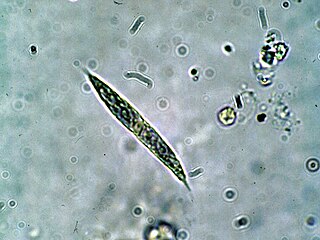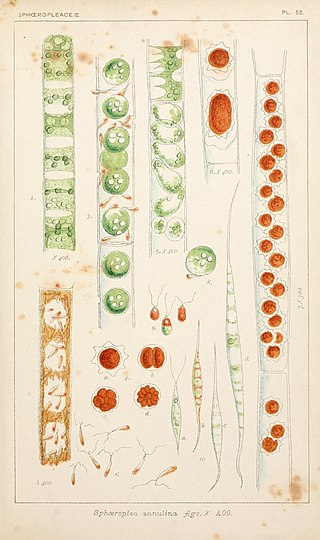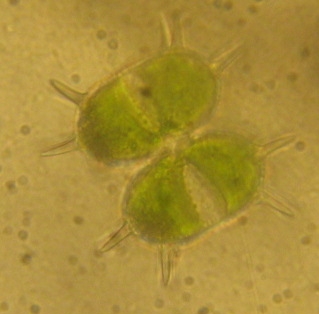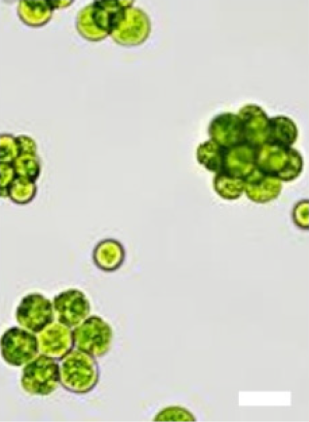
Chlamydomonas is a genus of green algae consisting of about 150 species of unicellular flagellates, found in stagnant water and on damp soil, in freshwater, seawater, and even in snow as "snow algae". Chlamydomonas is used as a model organism for molecular biology, especially studies of flagellar motility and chloroplast dynamics, biogenesis, and genetics. One of the many striking features of Chlamydomonas is that it contains ion channels (channelrhodopsins) that are directly activated by light. Some regulatory systems of Chlamydomonas are more complex than their homologs in Gymnosperms, with evolutionarily related regulatory proteins being larger and containing additional domains.

Characium is a genus of green algae in the family Characiaceae. It is very commonly found in freshwater habitats, where it is attached to phytoplankton or zooplankton.

Desmodesmus is a genus of green algae in the family Scenedesmaceae. It is the only chlorophyll-containing organism known to have caused human infections in immunocompetent individuals. All known cases involved open injuries occurring in fresh water.

Neochloris is a genus of green algae in the family Neochloridaceae. It is found in freshwater aquatic and terrestrial soil habitats.
Polyedriopsis is a genus of green algae in the order Sphaeropleales. As of February 2022, it contained a single species, Polyedriopsis spinulosa. It is found worldwide in freshwater habitats as phytoplankton, but is rare.
Pseudoschroederia is a genus of green algae in the family Characiaceae. It is planktonic in freshwater habitats, and probably has a cosmopolitan distribution. The genus Pseudoschroederia was circumscribed by Eberhard Hegewald and Eberhard Schnepf in 1986. The genus was distinguished from the similar Schroederia by being heteropolar and differing cell structure. However, some authors do not consider the genera to be separate.

Quadrigula is a genus of green algae in the family Selenastraceae. It is commonly found in freshwater habitats as phytoplankton.

Radiofilum is a genus of green algae in the class Chlorophyceae. It is a freshwater genus; they are often found in soft, boggy or acidic waters.

Schroederia is a genus of green algae in the family Schroederiaceae. Schroederiaceae is a monotypic taxon; Schroederia is its only genus.

Sphaeroplea is a genus of green algae in the family Sphaeropleaceae. It was first circumscribed by the Swedish botanist Carl Adolph Agardh in 1824.

Stephanosphaera is a genus of green algae in the family Haematococcaceae, containing the single species Stephanosphaera pluvialis. It forms colonies of flagellated cells. Although it was once placed in the family Volvocaceae, it is not closely related to them; its sister is the unicellular genus Balticola. The name comes from the Greek roots stephanos, meaning "crown", and sphaira, meaning "ball".
Tetracystis is a genus of green algae, in the family Chlorococcaceae. It is a terrestrial genus typically found in soils.

Treubaria is a genus of microscopic green algae, the sole genus in the family Treubariaceae. Treubaria is found in freshwater habitats and has a cosmopolitan distribution.
Vitreochlamys is a genus of green algae in the family Chlamydomonadaceae. It is sometimes known by the name Sphaerellopsis, published by Aleksandr Arkadievich Korshikov. However, that name is an illegitimate later homonym, preceded by SphaerellopsisM.C.Cooke. It is commonly found in freshwater habitats.

Cosmarium is a large genus of desmids (Desmidiaceae), a group of green algae closely related to the land plants (Embryophyta). Members of this genus are microscopic and found in freshwater habitats around the world.

Staurodesmus is a genus of green algae, specifically of the Desmidiaceae.

Xanthidium is a genus of green algae, specifically of the Desmidiaceae.

Deasonia is a genus of green algae, in the family Actinochloridaceae. It is found in soils.

Klebsormidium is a genus of filamentous charophyte green algae comprising 20 species. The name was proposed in 1972 to resolve confusion in application and status of Hormidium and was given for the German botanist Georg Albrecht Klebs.

Apiocystis is a genus of algae belonging to the family Tetrasporaceae. It is found attached to freshwater aquatic algae or plants. The species of this genus are found in Europe and Northern America, and are widespread but generally uncommon.
















